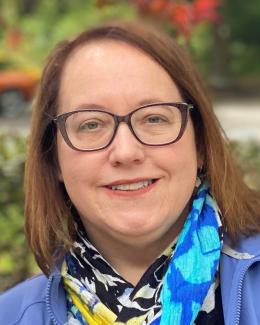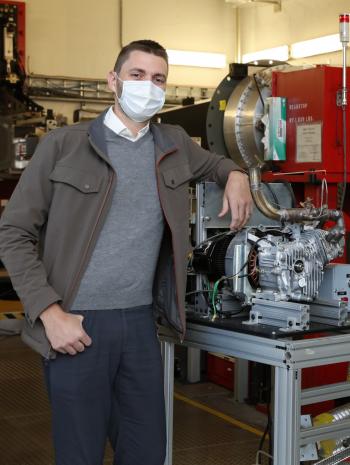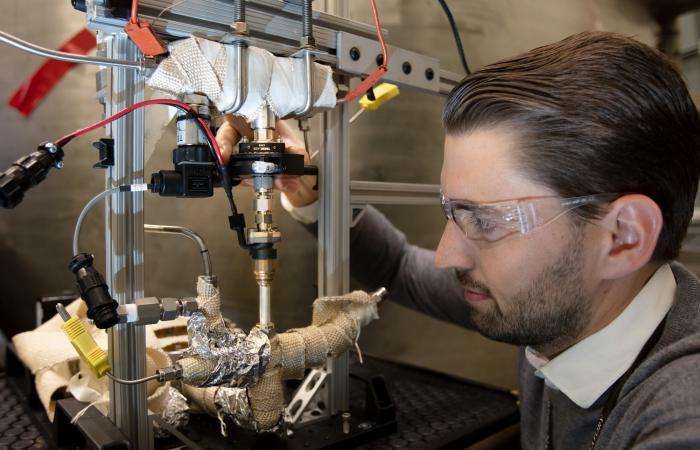For a researcher who started out in mechanical engineering with a focus on engine combustion, Martin Wissink has learned a lot about neutrons on the job.
Wissink came to Oak Ridge National Laboratory as a postdoc with a keen interest in the lab’s big science tools, including its unrivaled neutron diagnostic capabilities. Much of his work the last few years has been to deploy those tools in the search for better materials and designs for ultra-efficient advanced combustion engines with low emission profiles. These engines, most likely running on alternative fuels, are expected to serve as a bridge to a fully decarbonized transportation sector.
Wissink helped design an experiment in which scientists analyzed an engine cylinder cast from an ORNL aluminum-cerium alloy, or Al-Ce, to explore how the material would perform in realistic operating conditions. Wissink and his colleagues operated the running engine inside the VULCAN beam line at the Spallation Neutron Source at ORNL, a Department of Energy Office of Science user facility. The experiment was the world’s first of its kind, using neutrons to explore the material’s response at the atomic level to extreme temperatures and stress.
The project was so successful that the researchers are expanding the capability with the development of a research engine at industry-relevant scale for express use in VULCAN, dubbed the neutronic engine, to vet new materials and computational models of engine designs.
Wissink’s work lies in the challenge of creating a better combustion engine that simultaneously improves efficiency, reduces emissions, runs on renewable fuels and meets the practical constraints for vehicles. It is not an easy task, and the ability to use neutrons can greatly speed the work.
“We are the leading institution in the country for neutron diagnostics,” he said. “Additionally, we have the nation’s fastest supercomputer, Summit, as well as expertise in materials and advanced manufacturing, and the country’s only DOE user facility dedicated to transportation science, ORNL’s National Transportation Research Center. The kind of work I’m doing, especially on the neutronic engine, relies on many of these parts being in one place; it makes this work possible.”
Wissink grew up in California’s Sacramento Valley with a passion for tinkering — building his own computers and doing projects around the house. He earned both his bachelor’s and master’s degrees in mechanical engineering at the University of California, Berkeley.
He had become interested in engine combustion research as an undergrad. After earning his master’s, he followed a mentor to the University of Wisconsin, Madison, and its Engine Research Center, where he earned his doctorate. During his doctoral studies, Wissink twice won the prestigious Myers Award for Outstanding Student Paper from SAE International (Society of Automotive Engineers). One of his colleagues at U-Wisconsin later went to work at ORNL and persuaded Wissink to check out the lab’s broad scientific facilities.
Drawn to ORNL’s breadth of disciplines, tools
“I came to Tennessee to have Thanksgiving with him [my colleague] one year, and he gave me a tour. At the time I didn’t know anything about neutrons or the supercomputers here. It seemed like just a crazy place, all the research tools and so many different disciplines. That’s one reason I chose mechanical engineering in the first place. It’s the broadest engineering field, and I had a lot of interests,” Wissink said.
He landed a postdoctoral position at ORNL, initially working on spark-ignited engine research with gasoline fuels. He then worked on a project involving reactivity-controlled compression ignition, an alternative combustion strategy in which two fuels are used in an engine at the same time to improve efficiency and lower emissions. Wissink later began pursuing neutrons for nondestructive evaluation when fellow researchers wanted to test the Al-Ce alloy on an engine.
Wissink enjoys finding new transportation applications for neutron diagnostics – especially in challenging cases where experiments have been difficult to perform, such as those that require special sample environments, complex logistics, real-time examination or time-resolved conditions.
“I want to watch an engine while it’s running, or I want to watch an injector while it’s actually spraying fuel, or I want to watch a solvent permeating a polymer,” Wissink said. “I like creating proof-of-concept projects and doing outlandish things like running an engine in a beam line. These capabilities can help users on the applied end of the research spectrum bridge the gap to an experiment that will test their concepts.”
Tying together myriad science tools at the nation’s largest physical sciences lab goes straight to Wissink’s passion for multidisciplinary research. He referenced a quote from engine researcher Phil Myers: “The engine is the ideal teaching tool. It features all of the elements of engineering: materials, fluids, thermodynamics, lubrication, chemistry, electronics, etc. The only thing missing is nuclear reaction.” Wissink added, “Now we've got some nuclear reactions, too.”
UT-Battelle manages ORNL for the Department of Energy’s Office of Science, the single largest supporter of basic research in the physical sciences in the United States. The Office of Science is working to address some of the most pressing challenges of our time. For more information, please visit energy.gov/science.




